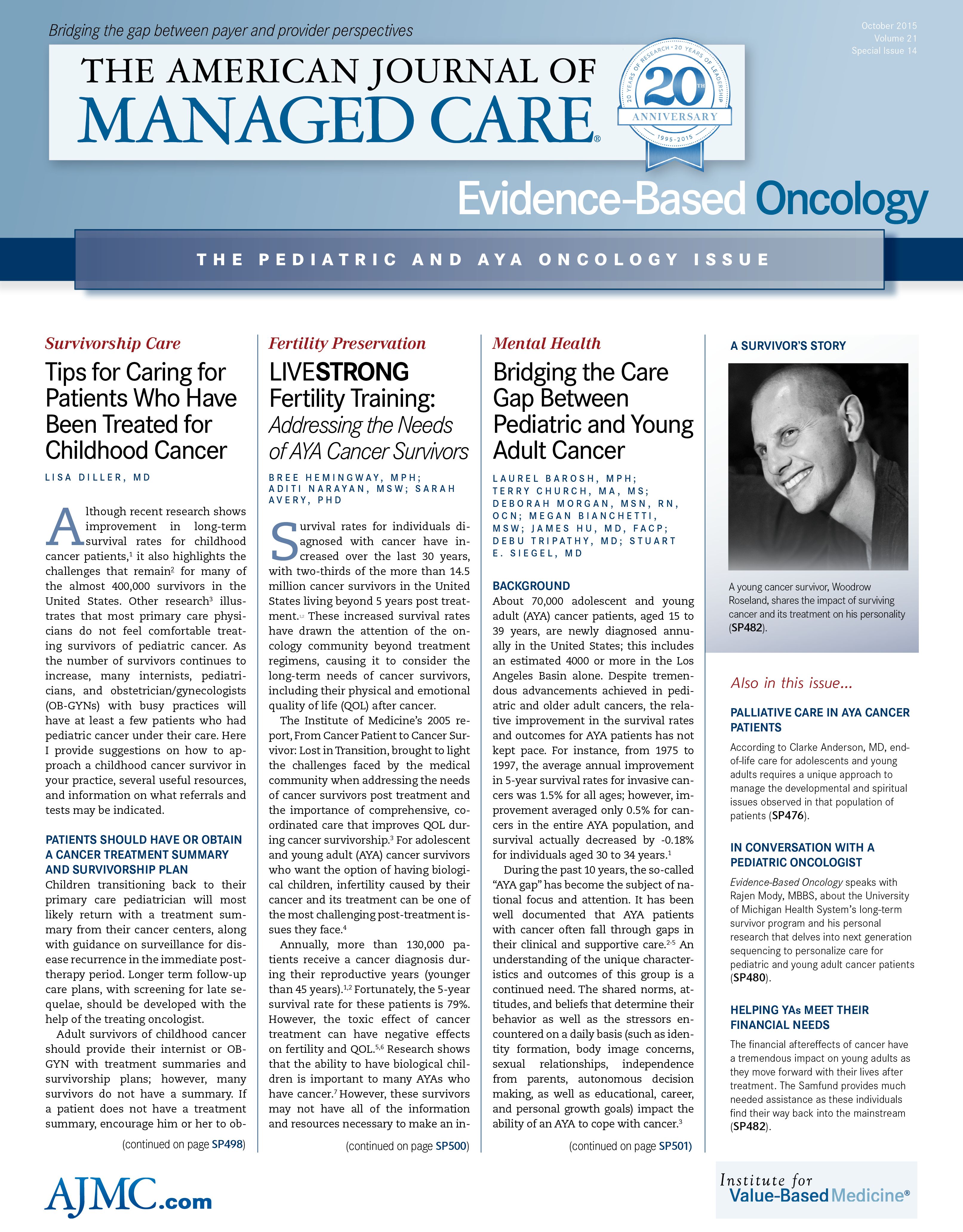- Center on Health Equity & Access
- Clinical
- Health Care Cost
- Health Care Delivery
- Insurance
- Policy
- Technology
- Value-Based Care
Coordinated, Personalized Care to Improve AYA Outcomes
A missed opportunity in cancer care, according to Joseph Alvarnas, MD, is the use of age-adapted treatment strategies for adolescent and young-adult patients (AYA).
Over the past decade, there has been a push toward improving cancer care outcomes through the use of personalized medicine and precision medicine solutions. As researchers and clinicians have come to appreciate the extraordinary biological complexity of cancer, they have sought to develop individually tailored plans to most effectively meet patients’ care needs. Much of our discussion regarding personalized medicine, however, has focused upon molecular and genomic data and the use of targeted therapeutic agents. In the rush to avail ourselves of these technology-based approaches, we have lost sight of some incredibly important opportunities to dramatically improve patient outcomes using existing technologies. One such missed opportunity is the use of age-adapted treatment strategies for adolescent and young-adult patients (AYA).
Many profound improvements in pediatric cancer survival outcomes have occurred through the use of increasingly intensive chemotherapeutic regimens. The AYA age group is defined as those patients between 15 and 39 years of age. Biologically, these patients are often healthier and better suited to receive more intensive therapeutic approaches than those used to treat older adult patients. By carefully considering AYA patients as candidates for pediatric- adapted or inspired regimens, we may be able to replicate the success of treating pediatric-aged patients in this older population.
In acute lymphoblastic leukemia (ALL), the survival outcomes for AYA patients treated with pediatric-inspired regimens are dramatically better than those of patients not receiving these therapeutic approaches. A study comparing survival outcomes between young adults treated with adult regimens on CALGB (Cancer and Leukemia Group B) trials vs those treated with pediatric regimens on CCG (Children’s Cancer Group) trials found markedly superior survival among patients treated using pediatric regimens. The 6-year event-free survival rates were 64% for those patients treated using pediatric regimens vs only 38% for those treated using adult regimens.1 Improved survival outcomes have also been demonstrated for AYA patients receiving pediatric- type treatment regimens for other types of cancer.
We have been slow to adapt to the use of AYA—appropriate regimens, and there is an opportunity gap in the number of AYA patients who receive age-appropriate therapeutic approaches.2 As such this remains a significant, on-going disparity within the cancer care system. Some of the root causes for this disparity include lack of clinician knowledge of the need for approaching the AYA population differently, lack of provider expertise in delivering these more intensive therapeutic regimens, concerns regarding the management of treatment toxicities, and gaps in patient knowledge regarding best practice for the care of their illness.
This issue of Evidence-Based Oncology is focused on addressing these barriers to care. Contributors to this issue include Dr Lisa Diller, chief medical officer at the Dana-Farber/Boston Children’s Cancer and Blood Disorders Center who provides guidelines on caring for AYA cancer survivors. Dr Joseph Rosenthal, chair of the Department of Pediatrics at City of Hope reviews the evidence for the use of pediatric-adapted therapeutic regimens for the care of AYA patients with ALL. Dr Clark Anderson explores the unique emotional and psychosocial issues associated with caring for this patient population.
EBO
References
1. Stock W, Satjer H, Dodge R, Bloomfield CD, Larson RA, Nachman J. Outcome of adolescents and young adults with ALL: a comparison of Children’s Cancer Group (CCG) and Cancer and Leukemia Group B (CALGB) regimens [abstract]. Blood. 2000;96:467a.
2. Lewis DR, Seibel NL, Smith AW, Stedman MR. Adolescent and young adult cancer survival. J Natl Cancer Inst Monogr. 2014;49:228-235.
While so much of the recent focus on improving cancer care is placed upon novel and targeted therapeutics, AYA patients may achieve significant improvements in their cure rates by making more effective use of existing technologies. By educating oncologists, hematologists, supportive care medicine providers, and the broader cancer care community on the importance of more effectively leveraging best practice for this unique patient population, we may make a profound difference in our patients’ lives and their prospects for a cancer-free future. Joseph Alvarnas, MD, is associate clinical professor and director of medical quality and quality, risk, and regulatory management, City of Hope, Duarte, CA. He is also the editor-in-chief of Evidence-Based Oncology.


